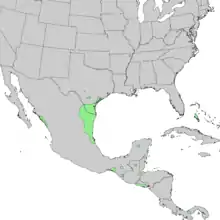Sideroxylon celastrinum
Sideroxylon celastrinum is a species of flowering plant in the family Sapotaceae, that is native to Texas[2] and Florida[4] in the United States south through Central America to northern Venezuela and Colombia in South America. Common names include saffron plum[5] and coma.[6][7] It is a spiny shrub or small tree that reaches a height of 2–9 m (6.6–29.5 ft). The dark green leaves are alternate or fascicled at the nodes and oblanceolate to obovate. Greenish-white flowers are present from May to November and are followed by single-seeded, blue-black drupes.[8]
| Sideroxylon celastrinum | |
|---|---|
.gif) | |
| Scientific classification | |
| Kingdom: | Plantae |
| Clade: | Tracheophytes |
| Clade: | Angiosperms |
| Clade: | Eudicots |
| Clade: | Asterids |
| Order: | Ericales |
| Family: | Sapotaceae |
| Genus: | Sideroxylon |
| Species: | S. celastrinum |
| Binomial name | |
| Sideroxylon celastrinum | |
 | |
| Natural range of Sideroxylon celastrinum | |
| Synonyms | |
Uses
This plant is known as a first choice deer feed.[6]
Synonyms
References
- IUCN SSC Global Tree Specialist Group & Botanic Gardens Conservation International (BGCI) (2020). "Sideroxylon celastrinum". IUCN Red List of Threatened Species. 2020: e.T156753924A156771602. doi:10.2305/IUCN.UK.2020-1.RLTS.T156753924A156771602.en. Retrieved 2 November 2022.
- "Sideroxylon celastrinum". Germplasm Resources Information Network. Agricultural Research Service, United States Department of Agriculture. Retrieved 2009-11-25.
- "Sideroxylon celastrinum". Integrated Taxonomic Information System. Retrieved 2011-10-07.
- Wunderlin, R. P.; Hansen, B. F. "Sideroxylon celastrinum". Atlas of Florida Vascular Plants. Plantatlas.org. Retrieved 2009-01-27.
- USDA, NRCS (n.d.). "Sideroxylon celastrinum". The PLANTS Database (plants.usda.gov). Greensboro, North Carolina: National Plant Data Team. Retrieved 14 November 2015.
- Daniel J. Kunz; Eric P. Garza; Michael W. Wallace. "Common Woody Browse Plants Utilized by White-Tailed Deer in South Texas" (PDF). Tpwd.state.tx.us. Retrieved 2022-03-27.
- "Woods Roamer: Coma Brushland Fruit". Woodsroamer.blogspot.com. 1 June 2011.
- Everitt, J. H.; Dale Lynn Drawe; Robert I. Lonard (2002). Trees, Shrubs, and Cacti of South Texas. Texas Tech University Press. p. 190. ISBN 978-0-89672-473-0.
External links
Wikimedia Commons has media related to Sideroxylon celastrinum.
Wikispecies has information related to Sideroxylon celastrinum.
- "Bumelia celastrina" (PDF). Digital Representations of Tree Species Range Maps from "Atlas of United States Trees" by Elbert L. Little, Jr. (and other publications). United States Geological Survey.
This article is issued from Wikipedia. The text is licensed under Creative Commons - Attribution - Sharealike. Additional terms may apply for the media files.
